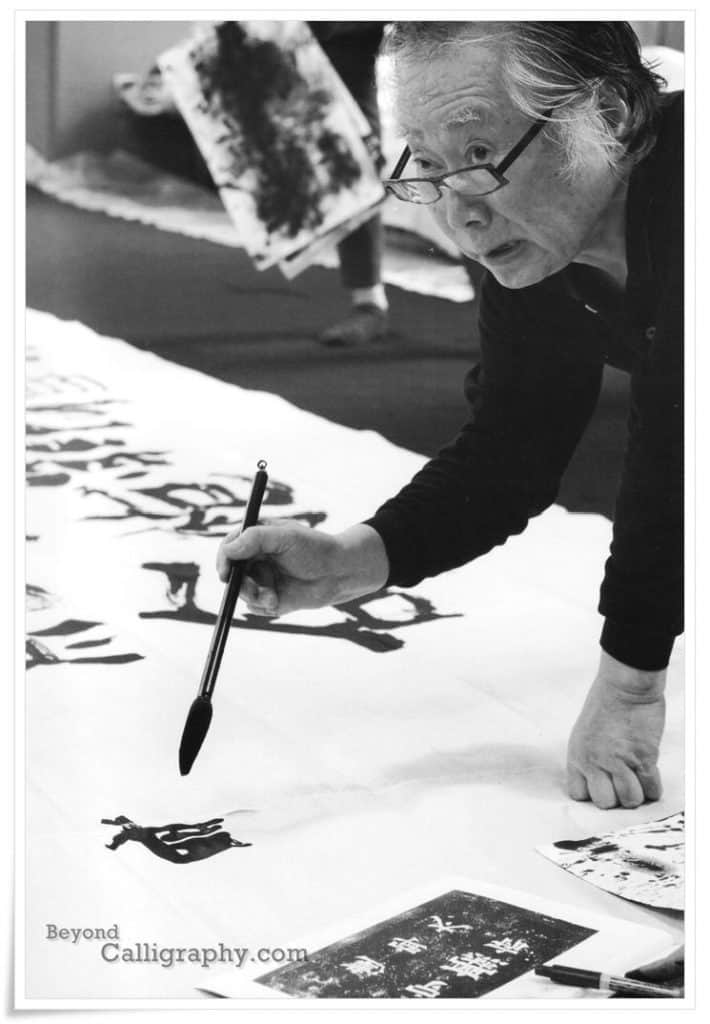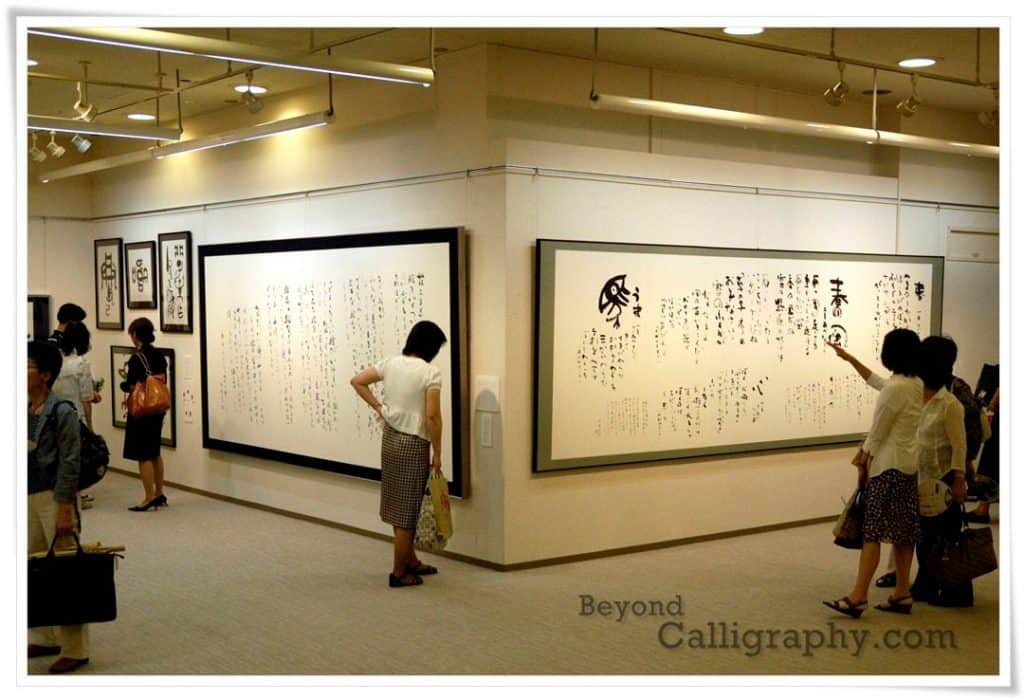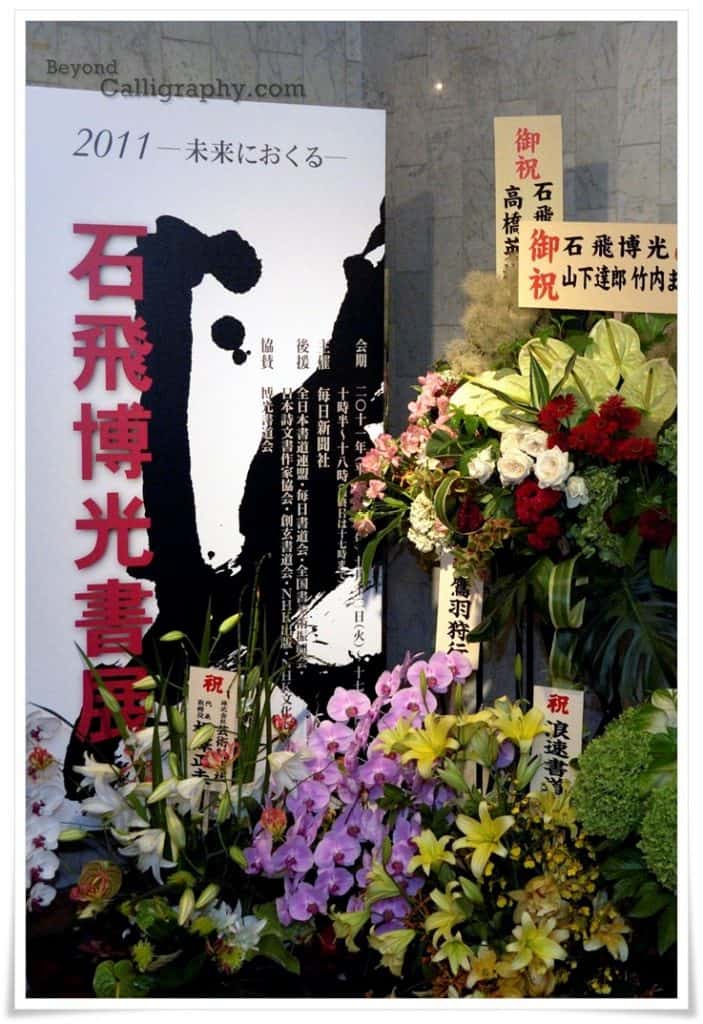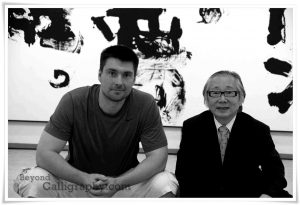Colourful black and white world.
In July, Beyond Calligraphy visited the calligraphy exhibition of Master Ishitobi Hakkō (石飛博光, いしとびはっこう). The event was titled “Into the future” (未来におくる, みらいにおくる) and it was a truly thrilling experience to be there. When I met him during this year’s exhibition, I could not believe that he is 70 years old. His bright aura and positive energy, emanating from the entire person, created a specific ambience during the event. Before, we reveal more about the exhibition itself however, we ought to introduce the master behind the brush.

Master Ishitobi Hakkō dedicated his entire life to the art of calligraphy. It is impossible to list all of his achievements and contributions to the subject, so I will only focus on a few examples here.

Master Ishitobi Hakkō was born in Hokkaidō in 1941. He graduated from Tōkyō Liberal Arts College, Oriental Calligraphy Department (東京学芸大学書道科). From the age of 21 he was already receiving awards for his excellent works during calligraphy exhibitions (毎日展, まいにちてん, Mainichi Ten, lit. “Everyday Exhibition”, the name of one of the annual exhibitions in Japan). From 1979 he became a lecturer on a series of the NHK programs (NKH is the national Japanese TV station) on the subject of calligraphy. His active cooperation with NHK, and other TV stations, is still ongoing. In 1986 he published his first book entitled “Introduction to the beauty of calligraphy” (書の美への誘い, しょのびへのさそい, sho no bi he no sasoi). In 2001 he became the head of All Japan Calligraphy Federation (全日本書道連盟理事事務局長, ぜんにほんしょどうれんめいりじじむきょくちょう) In 2002 he released a series of 10 books on calligraphy classics entitled “Collection of rinsho – extensive reading of calligraphy classics” (臨書集『古典渉猟』(全10集), りんしょしゅう「こてんしょうりょう」ぜんじゅうしゅう). In 2003 he became the chief of the Association of Modern Poetry Writers 近代詩文書作家協会事務局長 (きんだいしぶんしょさっかきょうかいじむきょくちょう). In 2006 he took the position of vice-board chairman of The Association of Japanese Poetry and Prose in Calligraphy (日本詩文書作家協会副理事長, にほんしぶんしょさっかきょうかいふくりじちょう). As I said at the beginning of my article, this is only a brief summary of his personal achievements in the field of calligraphy. On top of all this, Master Ishitobi Hakkō held or participated in numerous exhibitions, published many articles and created countless spectacular calligraphy works.

This July’s exhibit was held in Ginza Art Gallery, in a prestigious district in Tōkyō. It is not common for calligraphers to hold named exhibitions (one person events). Only the most famous artists receive enough publicity to ensure that such exhibition will be successful. Personally, I have never seen more people during single calligrapher’s exhibition. The event was dominated by large scale modern calligraphy, written in Japanese 調和体 (ちょうわたい, chōwatai, i.e. “harmony of styles/scripts”). Chōwatai is a calligraphy style that combines all writing systems of the modern Japanese language (kanji, hiragana, and katakana). Master Ishitobi Hakkō specializes in this style, as it is a common way of expressing feelings for modern Japanese poe

ts and calligraphers. Chōwatai calligraphy may seem to an inexperienced viewer as a maze of lines dots and splashes, though in reality it requires sound foundations in classic calligraphy, many years spent with a brush and ink, and quite an imagination. Executed by the hand of a master, it’s an extremely dynamic, expressive and powerful form of art.
Preparation for this exhibition must have taken months of hard work. Some of the works displayed absolutely dwarfed the viewers, both in their size and expressiveness. We will present selected works in great detail in part 2 and part 3 of this article.
